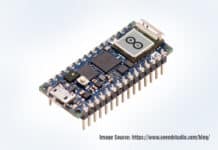An “Oops” is what the kernel throws at us when it finds something faulty, or an exception, in the kernel code. It’s somewhat like the segfaults of user-space. An Oops dumps its message on the console; it contains the processor status and the CPU registers of when the fault occurred. The offending process that triggered this Oops gets killed without releasing locks or cleaning up structures. The system may not even resume its normal operations sometimes; this is called an unstable state. Once an Oops has occurred, the system cannot be trusted any further.
Let’s try to generate an Oops message with sample code, and try to understand the dump.
Setting up the machine to capture a Kernel Oops
The running kernel should be compiled with CONFIG_DEBUG_INFO, and syslogd should be running. To generate and understand an Oops message, Let’s write a sample kernel module, oops.c:
#include <linux/kernel.h>
#include <linux/module.h>
#include <linux/init.h>
static void create_oops() {
*(int *)0 = 0;
}
static int __init my_oops_init(void) {
printk("oops from the module\n");
create_oops();
return (0);
}
static void __exit my_oops_exit(void) {
printk("Goodbye world\n");
}
module_init(my_oops_init);
module_exit(my_oops_exit);
The associated Makefile for this module is as follows:
obj-m := oops.o KDIR := /lib/modules/$(shell uname -r)/build PWD := $(shell pwd) SYM=$(PWD) all: $(MAKE) -C $(KDIR) SUBDIRS=$(PWD) modules
Once executed, the module generates the following Oops:
BUG: unable to handle kernel NULL pointer dereference at (null) IP: [<ffffffffa03e1012>] my_oops_init+0x12/0x21 [oops] PGD 7a719067 PUD 7b2b3067 PMD 0 Oops: 0002 [#1] SMP last sysfs file: /sys/devices/virtual/misc/kvm/uevent CPU 1 Pid: 2248, comm: insmod Tainted: P 2.6.33.3-85.fc13.x86_64 RIP: 0010:[<ffffffffa03e1012>] [<ffffffffa03e1012>] my_oops_init+0x12/0x21 [oops] RSP: 0018:ffff88007ad4bf08 EFLAGS: 00010292 RAX: 0000000000000018 RBX: ffffffffa03e1000 RCX: 00000000000013b7 RDX: 0000000000000000 RSI: 0000000000000046 RDI: 0000000000000246 RBP: ffff88007ad4bf08 R08: ffff88007af1cba0 R09: 0000000000000004 R10: 0000000000000000 R11: ffff88007ad4bd68 R12: 0000000000000000 R13: 00000000016b0030 R14: 0000000000019db9 R15: 00000000016b0010 FS: 00007fb79dadf700(0000) GS:ffff880001e80000(0000) knlGS:0000000000000000 CS: 0010 DS: 0000 ES: 0000 CR0: 000000008005003b CR2: 0000000000000000 CR3: 000000007a0f1000 CR4: 00000000000006e0 DR0: 0000000000000000 DR1: 0000000000000000 DR2: 0000000000000000 DR3: 0000000000000000 DR6: 00000000ffff0ff0 DR7: 0000000000000400 Process insmod (pid: 2248, threadinfo ffff88007ad4a000, task ffff88007a222ea0) Stack: ffff88007ad4bf38 ffffffff8100205f ffffffffa03de060 ffffffffa03de060 0000000000000000 00000000016b0030 ffff88007ad4bf78 ffffffff8107aac9 ffff88007ad4bf78 00007fff69f3e814 0000000000019db9 0000000000020000 Call Trace: [<ffffffff8100205f>] do_one_initcall+0x59/0x154 [<ffffffff8107aac9>] sys_init_module+0xd1/0x230 [<ffffffff81009b02>] system_call_fastpath+0x16/0x1b Code: <c7> 04 25 00 00 00 00 00 00 00 00 31 c0 c9 c3 00 00 00 00 00 00 00 RIP [<ffffffffa03e1012>] my_oops_init+0x12/0x21 [oops] RSP <ffff88007ad4bf08> CR2: 0000000000000000
Understanding the Oops dump
Let’s have a closer look at the above dump, to understand some of the important bits of information.
BUG: unable to handle kernel NULL pointer dereference at (null)
The first line indicates a pointer with a NULL value.
IP: [<ffffffffa03e1012>] my_oops_init+0x12/0x21 [oops]
IP is the instruction pointer.
Oops: 0002 [#1] SMP
This is the error code value in hex. Each bit has a significance of its own:
bit 0== 0 means no page found, 1 means a protection faultbit 1== 0 means read, 1 means writebit 2== 0 means kernel, 1 means user-mode[#1]— this value is the number of times the Oops occurred. Multiple Oops can be triggered as a cascading effect of the first one.
CPU 1
This denotes on which CPU the error occurred.
Pid: 2248, comm: insmod Tainted: P 2.6.33.3-85.fc13.x86_64
The Tainted flag points to P here. Each flag has its own meaning. A few other flags, and their meanings, picked up from kernel/panic.c:
P— Proprietary module has been loaded.F— Module has been forcibly loaded.S— SMP with a CPU not designed for SMP.R— User forced a module unload.M— System experienced a machine check exception.B— System has hit bad_page.U— Userspace-defined naughtiness.A— ACPI table overridden.W— Taint on warning.
RIP: 0010:[<ffffffffa03e1012>] [<ffffffffa03e1012>] my_oops_init+0x12/0x21 [oops]
RIP is the CPU register containing the address of the instruction that is getting executed. 0010 comes from the code segment register. my_oops_init+0x12/0x21 is the <symbol> + the offset/length.
RSP: 0018:ffff88007ad4bf08 EFLAGS: 00010292 RAX: 0000000000000018 RBX: ffffffffa03e1000 RCX: 00000000000013b7 RDX: 0000000000000000 RSI: 0000000000000046 RDI: 0000000000000246 RBP: ffff88007ad4bf08 R08: ffff88007af1cba0 R09: 0000000000000004 R10: 0000000000000000 R11: ffff88007ad4bd68 R12: 0000000000000000 R13: 00000000016b0030 R14: 0000000000019db9 R15: 00000000016b0010
This is a dump of the contents of some of the CPU registers.
Stack: ffff88007ad4bf38 ffffffff8100205f ffffffffa03de060 ffffffffa03de060 0000000000000000 00000000016b0030 ffff88007ad4bf78 ffffffff8107aac9 ffff88007ad4bf78 00007fff69f3e814 0000000000019db9 0000000000020000
The above is the stack trace.
Call Trace: [<ffffffff8100205f>] do_one_initcall+0x59/0x154 [<ffffffff8107aac9>] sys_init_module+0xd1/0x230 [<ffffffff81009b02>] system_call_fastpath+0x16/0x1b
The above is the call trace — the list of functions being called just before the Oops occurred.
Code: <c7> 04 25 00 00 00 00 00 00 00 00 31 c0 c9 c3 00 00 00 00 00 00 00
The Code is a hex-dump of the section of machine code that was being run at the time the Oops occurred.
Debugging an Oops dump
The first step is to load the offending module into the GDB debugger, as follows:
[root@DELL-RnD-India oops]# gdb oops.ko GNU gdb (GDB) Fedora (7.1-18.fc13) Reading symbols from /code/oops/oops.ko...done. (gdb) add-symbol-file oops.o 0xffffffffa03e1000 add symbol table from file "oops.o" at .text_addr = 0xffffffffa03e1000
Next, add the symbol file to the debugger. The add-symbol-file command’s first argument is oops.o and the second argument is the address of the text section of the module. You can obtain this address from /sys/module/oops/sections/.init.text (where oops is the module name):
(gdb) add-symbol-file oops.o 0xffffffffa03e1000 add symbol table from file "oops.o" at .text_addr = 0xffffffffa03e1000 (y or n) y Reading symbols from /code/oops/oops.o...done.
From the RIP instruction line, we can get the name of the offending function, and disassemble it.
(gdb) disassemble my_oops_init Dump of assembler code for function my_oops_init: 0x0000000000000038 <+0>: push %rbp 0x0000000000000039 <+1>: mov $0x0,%rdi 0x0000000000000040 <+8>: xor %eax,%eax 0x0000000000000042 <+10>: mov %rsp,%rbp 0x0000000000000045 <+13>: callq 0x4a <my_oops_init+18> 0x000000000000004a <+18>: movl $0x0,0x0 0x0000000000000055 <+29>: xor %eax,%eax 0x0000000000000057 <+31>: leaveq 0x0000000000000058 <+32>: retq End of assembler dump.
Now, to pin point the actual line of offending code, we add the starting address and the offset. The offset is available in the same RIP instruction line. In our case, we are adding 0x0000000000000038 + 0x012 = 0x000000000000004a. This points to the movl instruction.
(gdb) list *0x000000000000004a
0x4a is in my_oops_init (/code/oops/oops.c:6).
1 #include <linux/kernel.h>
2 #include <linux/module.h>
3 #include <linux/init.h>
4
5 static void create_oops() {
6 *(int *)0 = 0;
7 }
This gives the code of the offending function.
References
The kerneloops.org website can be used to pick up a lot of Oops messages to debug. The Linux kernel documentation directory has information about Oops — kernel/Documentation/oops-tracing.txt. This, and numerous other online resources, were used while creating this article.
















































































Anonymous-OS
I Love Linux and I Hate Windows….
Anonymous-OS is the best Operating Sistem for haking
Backtrack is the best for hacking :-p
know programming, know hacking
no programming, no hacking
pre-compiled tools == shit
self made tools == awesome
OS == no matter
I use Ubuntu and I crashed my college linux server in mere 15 lines of Perl ;)
try anonymous’s OS ;)
Great
post my friend, very nice. congrats! if you have some time, take a look on my
page, is linked to my name.
Hi Thanks for the post…but i would like to know the cases where we use the other log details (also) like stack/call trace/Code: ..etc…what is the purpose of them to have in log detail..can you please explain..
Nice article, thanks!
Hi,
I want to know the meaning of “(OF)” or “(OF+)” in kernel trace.
Eg: Here is one of the kernel trace i got.
general protection fault: 0000 [#1]
Modules linked in: cxgb4(OF+) toecore(OF) ip6table_filter ip6_tables
ebtable_nat ebtables nf_conntrack_ipv4 nf_defrag_ipv4 xt_state nf_conntrack
…..
….
Thanks a lot
I’m curious how you get the address of the text section of the module? If you load this module, then the kernel oops. How you read the file /sys/module/oops/sections/.init.text?
my_oops_init+0x12/0x21 is the + the offset/length :
In this what is length???
we have to put this —–>static void create_oops(void)
instead——>static void create_oops()
If your function does not take any parameters, you must specify that it is (void).
Then only we can avoid error.